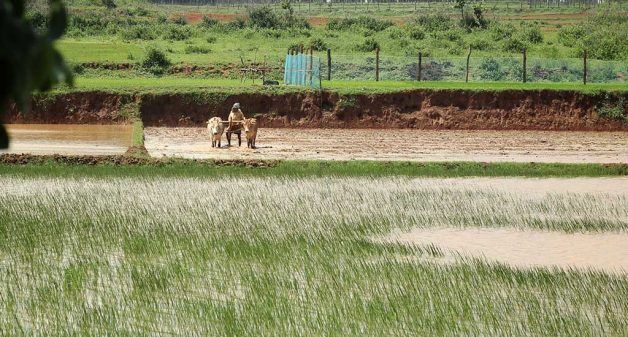Both the Ministry of Rural Development and the Ministry of Agriculture and Farmers’ Welfare will get slightly more funds this year, but with no increase to the rural employment guarantee scheme will the 2022 budget help stop rural distress and the widening inequality made worse by COVID-19?
The 2022 budget: A quick glance
During Tuesday’s (Feb 1) presentation of the annual budget, Union Finance Minister Nirmala Sitharaman said India’s GDP is expected to grow at a whopping 9.2% this fiscal year and as per the Economic Survey 2022, it is expected to grow between 8 and 8.5% in the next one. Though it is a conservative estimate than the IMF’s prediction of 9% growth for the next two years, it still bodes well for the economy.
“This moment in history is the dawn of a new era, one in which India is well-poised to be the land of hope and promise,” Sitharaman said.

But India’s rich-poor divide is vast – with the top 1% holding 22% of the national income, while the bottom 50% hold just 13%, according to the World Inequality Report 2022.
And according to a report by the international non-profit organisation, the pandemic-induced lockdowns only pushed the poor further to the margins.
The 2022 budget: Not enough for India’s rural unemployed?
While the Department of Rural Development will be given Rs 1,35,944 crore, which is a 3.36% increase, the budgetary allocation for the Mahatma Gandhi National Rural Employment Guarantee Scheme (MGNREGS), remains Rs 73,000 crore.
This is despite the revised estimate, which is the mid-year review of possible expenditure for the year, of Rs 98,000 crore for 2021-22. This reduction seems even more significant when compared to the actual expenditure of Rs 1,11,170 crore in 2020-21.
For such a vital scheme, promising 100 days of employment to the rural poor, this is a massive cut of over 25% compared to the revised estimate.

The urban-rural migration brought on by COVID-19 meant demand for work under this scheme rose sharply. That is why many right-to-work activists are demanding an increase in allocation for MGNREGS, not stagnation.
The NREGA Sangharsh Morcha, a collective for MGNREGS workers, had hoped for “a conservative allocation of around Rs 3.62 lakh crore in the financial year 2022-23 for the effective implementation of the programme.” The actual allocated budget falls short by Rs 2.89 lakh crore.
The 2022 budget: Digging into the agriculture numbers
While the budget for the Ministry of Agriculture and Farmers’ Welfare is being conservatively increased by 4.5% to Rs 1,32,513 crore, the finance minister also announced new schemes for farmers in hopes of pivoting off the allied farms and the food processing sectors.
A new public-private partnership model for delivering digital and hi-tech services to farmers was announced, as well as a fund to launch agriculture start-ups and a scheme promoting kisan drones for crop assessment, digitalisation of land records and spraying of insecticides.

“This is to finance start-ups for agriculture and rural enterprise, relevant for farm produce value chain. The activities for these start-ups will include, inter alia, support for FPOs, machinery for farmers on rental basis at farm level, and technology including IT-based support,” the finance minister (FM) said.
But some in the agricultural sector did not think it was enough.
Professor R Ramakumar of the Tata Institute of Social Sciences (TISS) did not think enough attention was given to agriculture in the budget speech.
“The term agriculture is mentioned in the budget speech just seven times. It would be only five times if we left out one heading and one appendix. Of the five times, two are under natural farming, one is under customs duty, one is under NABARD and one is under stubble burning. That’s all!” Professor Ramakumar said.
But while funds for some key agricultural schemes have been cut, others have seen a marginal increase compared to last year.
For instance, the budget provides Rs 68,000 crore for the PM-KISAN scheme, which is 4.6% more than the fund allocated in 2021-22. Under this scheme, the government provides Rs 6,000 to the eligible beneficiary farmer families annually. About 12.50 crore farmer families are expected to be covered by this scheme.
Whereas the allocated fund for the Pradhan Mantri Fasal Bima Yojana (PMFBY) crop insurance scheme has been slashed to Rs 15,500 crore from Rs 16,000 crore. And after the year-long farmers protest demanding a guaranteed minimum support price (MSP) for purchasing wheat and paddy, the FM said Rs 2.37 lakh crore has been allocated to the scheme, benefiting some 1.63 crore farmers.
The finance minister also spoke about promoting chemical-free natural farming across India. Currently in India, only 2% of the total net sown area is under organic cultivation, according to the Union Ministry of Agriculture and Farmers’ Welfare.
However, some experts believe that this is a misguided priority.
“The focus on natural farming and chemical-free farming is a huge mistake and a misdirected emphasis in policy. Zero budget natural farming has no sanction among scientists in agriculture,” Professor Ramakumar said.
Other budget allocation for rural India in 2022
In addition to allocations for the Aajeevika livelihood mission programme, rural housing scheme, various pension schemes, etc., this year’s budget includes the following allocations:

- LPG: Against the revised estimate of Rs 1,618 crore (2021-22), only Rs 800 crore (almost half) has been allocated for ‘LPG connection to poor households’ in this year’s budget.
- Drinking water: 3.8 crore more households will be covered under the Har Ghar Jal Scheme in 2022-23. A sum of Rs 60,000 crore has been allocated for the same.
- Rural roads: Rs 19,000 crore has been allocated under the Pradhan Mantri Gram Sadak Yojana. This allocation is Rs 5,000 crore more than the revised estimate of Rs 14,000 crore for rural roads in 2021-22.
- Swachh Bharat Mission (Gramin): Swachh Bharat Mission (Gramin) received Rs 7,192 crores in the 2022-23 budget. Whereas in the 2021-22 budget, Rs 9,994 were allocated for this scheme.
- Internet coverage: Nirmala Sitharaman announced the government’s intention to lay optical fibres in all villages by 2025. This project will be commissioned via public-private partnership.
Rahul Raman is the content manager at Village Square.








